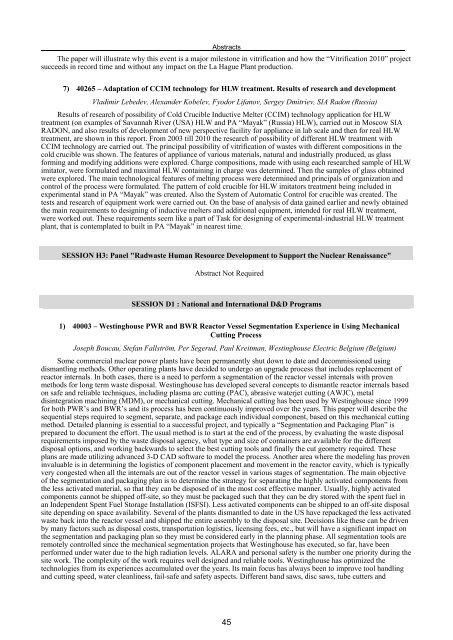The 13th International Conference on Environmental ... - Events
The 13th International Conference on Environmental ... - Events
The 13th International Conference on Environmental ... - Events
You also want an ePaper? Increase the reach of your titles
YUMPU automatically turns print PDFs into web optimized ePapers that Google loves.
Abstracts<br />
<str<strong>on</strong>g>The</str<strong>on</strong>g> paper will illustrate why this event is a major milest<strong>on</strong>e in vitrificati<strong>on</strong> and how the “Vitrificati<strong>on</strong> 2010” project<br />
succeeds in record time and without any impact <strong>on</strong> the La Hague Plant producti<strong>on</strong>.<br />
7) 40265 – Adaptati<strong>on</strong> of CCIM technology for HLW treatment. Results of research and development<br />
Vladimir Lebedev, Alexander Kobelev, Fyodor Lifanov, Sergey Dmitriev, SIA Rad<strong>on</strong> (Russia)<br />
Results of research of possibility of Cold Crucible Inductive Melter (CCIM) technology applicati<strong>on</strong> for HLW<br />
treatment (<strong>on</strong> examples of Savannah River (USA) HLW and PA “Mayak” (Russia) HLW), carried out in Moscow SIA<br />
RADON, and also results of development of new perspective facility for appliance in lab scale and then for real HLW<br />
treatment, are shown in this report. From 2003 till 2010 the research of possibility of different HLW treatment with<br />
CCIM technology are carried out. <str<strong>on</strong>g>The</str<strong>on</strong>g> principal possibility of vitrificati<strong>on</strong> of wastes with different compositi<strong>on</strong>s in the<br />
cold crucible was shown. <str<strong>on</strong>g>The</str<strong>on</strong>g> features of appliance of various materials, natural and industrially produced, as glass<br />
forming and modifying additi<strong>on</strong>s were explored. Charge compositi<strong>on</strong>s, made with using each researched sample of HLW<br />
imitator, were formulated and maximal HLW c<strong>on</strong>taining in charge was determined. <str<strong>on</strong>g>The</str<strong>on</strong>g>n the samples of glass obtained<br />
were explored. <str<strong>on</strong>g>The</str<strong>on</strong>g> main technological features of melting process were determined and principals of organizati<strong>on</strong> and<br />
c<strong>on</strong>trol of the process were formulated. <str<strong>on</strong>g>The</str<strong>on</strong>g> pattern of cold crucible for HLW imitators treatment being included in<br />
experimental stand in PA “Mayak” was created. Also the System of Automatic C<strong>on</strong>trol for crucible was created. <str<strong>on</strong>g>The</str<strong>on</strong>g><br />
tests and research of equipment work were carried out. On the base of analysis of data gained earlier and newly obtained<br />
the main requirements to designing of inductive melters and additi<strong>on</strong>al equipment, intended for real HLW treatment,<br />
were worked out. <str<strong>on</strong>g>The</str<strong>on</strong>g>se requirements seem like a part of Task for designing of experimental-industrial HLW treatment<br />
plant, that is c<strong>on</strong>templated to built in PA “Mayak” in nearest time.<br />
SESSION H3: Panel "Radwaste Human Resource Development to Support the Nuclear Renaissance"<br />
Abstract Not Required<br />
SESSION D1 : Nati<strong>on</strong>al and <str<strong>on</strong>g>Internati<strong>on</strong>al</str<strong>on</strong>g> D&D Programs<br />
1) 40003 – Westinghouse PWR and BWR Reactor Vessel Segmentati<strong>on</strong> Experience in Using Mechanical<br />
Cutting Process<br />
Joseph Boucau, Stefan Fallström, Per Segerud, Paul Kreitman, Westinghouse Electric Belgium (Belgium)<br />
Some commercial nuclear power plants have been permanently shut down to date and decommissi<strong>on</strong>ed using<br />
dismantling methods. Other operating plants have decided to undergo an upgrade process that includes replacement of<br />
reactor internals. In both cases, there is a need to perform a segmentati<strong>on</strong> of the reactor vessel internals with proven<br />
methods for l<strong>on</strong>g term waste disposal. Westinghouse has developed several c<strong>on</strong>cepts to dismantle reactor internals based<br />
<strong>on</strong> safe and reliable techniques, including plasma arc cutting (PAC), abrasive waterjet cutting (AWJC), metal<br />
disintegrati<strong>on</strong> machining (MDM), or mechanical cutting. Mechanical cutting has been used by Westinghouse since 1999<br />
for both PWR’s and BWR’s and its process has been c<strong>on</strong>tinuously improved over the years. This paper will describe the<br />
sequential steps required to segment, separate, and package each individual comp<strong>on</strong>ent, based <strong>on</strong> this mechanical cutting<br />
method. Detailed planning is essential to a successful project, and typically a “Segmentati<strong>on</strong> and Packaging Plan” is<br />
prepared to document the effort. <str<strong>on</strong>g>The</str<strong>on</strong>g> usual method is to start at the end of the process, by evaluating the waste disposal<br />
requirements imposed by the waste disposal agency, what type and size of c<strong>on</strong>tainers are available for the different<br />
disposal opti<strong>on</strong>s, and working backwards to select the best cutting tools and finally the cut geometry required. <str<strong>on</strong>g>The</str<strong>on</strong>g>se<br />
plans are made utilizing advanced 3-D CAD software to model the process. Another area where the modeling has proven<br />
invaluable is in determining the logistics of comp<strong>on</strong>ent placement and movement in the reactor cavity, which is typically<br />
very c<strong>on</strong>gested when all the internals are out of the reactor vessel in various stages of segmentati<strong>on</strong>. <str<strong>on</strong>g>The</str<strong>on</strong>g> main objective<br />
of the segmentati<strong>on</strong> and packaging plan is to determine the strategy for separating the highly activated comp<strong>on</strong>ents from<br />
the less activated material, so that they can be disposed of in the most cost effective manner. Usually, highly activated<br />
comp<strong>on</strong>ents cannot be shipped off-site, so they must be packaged such that they can be dry stored with the spent fuel in<br />
an Independent Spent Fuel Storage Installati<strong>on</strong> (ISFSI). Less activated comp<strong>on</strong>ents can be shipped to an off-site disposal<br />
site depending <strong>on</strong> space availability. Several of the plants dismantled to date in the US have repackaged the less activated<br />
waste back into the reactor vessel and shipped the entire assembly to the disposal site. Decisi<strong>on</strong>s like these can be driven<br />
by many factors such as disposal costs, transportati<strong>on</strong> logistics, licensing fees, etc., but will have a significant impact <strong>on</strong><br />
the segmentati<strong>on</strong> and packaging plan so they must be c<strong>on</strong>sidered early in the planning phase. All segmentati<strong>on</strong> tools are<br />
remotely c<strong>on</strong>trolled since the mechanical segmentati<strong>on</strong> projects that Westinghouse has executed, so far, have been<br />
performed under water due to the high radiati<strong>on</strong> levels. ALARA and pers<strong>on</strong>al safety is the number <strong>on</strong>e priority during the<br />
site work. <str<strong>on</strong>g>The</str<strong>on</strong>g> complexity of the work requires well designed and reliable tools. Westinghouse has optimized the<br />
technologies from its experiences accumulated over the years. Its main focus has always been to improve tool handling<br />
and cutting speed, water cleanliness, fail-safe and safety aspects. Different band saws, disc saws, tube cutters and<br />
45
















